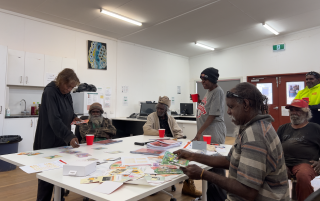Thousands of survivors of stroke struggling with everyday tasks have an opportunity to regain their sense of touch, thanks to a world-first therapy that is now available across three Australian states.
Developed by researchers at La Trobe University in Melbourne, SENSe therapy (Study of the Effectiveness of Neurorehabilitation on Sensation) has already helped hundreds of survivors of stroke improve their ability to undertake tasks such as cooking, dressing, eating and driving.
A unique partnership program, launching today – involving universities and healthcare providers across Victoria, New South Wales and South Australia, and 100 newly upskilled health professionals – will see SENSe therapy extend to thousands more patients.
Program lead, Professor Leeanne Carey from La Trobe University, said although one in two people – or more than 200,000 Australians – experience a loss of touch sensation after stroke, it’s largely a hidden problem.
“We may take touch sensation for granted – but for someone to suddenly not have this skill can erode confidence, independence and the ability to live a full and happy life.”
“Family members may see the person walking and talking and assume they can easily return to their everyday life, including tasks such as cooking – but this is often not the case,” Professor Carey said.
Professor Carey said making SENSe therapy more widely available is critical to enabling survivors of stroke to regain use of their hand in daily activities and improve quality of life.
“We now have four specialist SENSe therapy centres established in Melbourne, Adelaide and Newcastle – and a further 100 physiotherapists and occupational therapists upskilled to roll the therapy out across eight healthcare networks in Victoria and NSW,” Professor Carey said.
“Thanks to this new partnership, people can more easily access this highly effective, evidence-based therapy which has been in development for years – whether they recently had a stroke or have been struggling with everyday tasks for years.”
Professor Carey said most survivors of stroke who have been through the six-week program say the therapy has changed their life.
“SENSe therapy helps to reprogram the brain so that people again know when they are touching objects, can recognise textures, and know where their hand is in space,” Professor Carey said.
Robert Morgan, who had a stroke in 2002 as a 56-year-old, said he quickly learnt not to use his right dominant arm due to the loss of sensation that impacted the fine motor skills in his hand and greatly reduced movement and control of his arm.
“I taught myself to sign my name left-handed and decided that my left hand would have to be my dominant one – it was the only way I could get around the loss of touch and control. This was also a major contributing factor to the end of my 35-year career with Holden,” Mr Morgan said.
“Since the therapy my life has improved in many ways. I no longer need to use my left hand to fully compensate for the right hand in everyday situations such as tying up my shoelaces – and using my right hand ‘as normal’ to operate the turn signal switch in my car has naturally made me a safer driver.”
The partnership involves four specialist SENSe therapy centres – based at the Florey Institute/Austin Hospital, John Hunter Hospital, Alfred Health and UniSA Health – that will offer SENSe therapy for survivors of stroke living in the community. People who have stroke and sensory loss can self-refer.
Another 100 therapists at eight healthcare networks in both metro and regional areas are trained to deliver SENSe therapy – including at Austin Health, Barwon Health, Bendigo Health, Epworth HealthCare, Northern Sydney Local Health District, St John of God Frankston, St Vincent’s Health and Western Health.
The project also has financial support from the Stroke Foundation, and Chief Executive Sharon McGowan said the organisation is thrilled to see SENSe therapy now becoming available to thousands of Australians.
“We know that getting functionality back after stroke is a significant step in the recovery journey, and the SENSe therapy trials have already been transformational for so many survivors of stroke. We are looking forward to seeing so many more people have this opportunity,” Ms McGowan said.
“There are 445,000 living with the impact of stroke in Australia and no one person will have the same needs in their recovery journey. That is why new innovations like SENSe therapy are so important, and we congratulate Professor Carey and the team behind this really important work.”
About SENSe therapy:
- SENSe therapy exploits the brain’s capacity to adapt and learn new skills. Researchers now know that brain is plastic – it can change its function, even in adults who have had an injury to the brain such as stroke.
- The focus of the SENSe training approach is on rediscovering the sense of touch in the arms. It has been designed to assist survivors of stroke to improve functional sensory skills and be able to apply these in everyday tasks.
- SENSe has been successfully conducted by trained occupational therapists and physiotherapists. Therapists need to be specifically trained in the SENSe training program.
- SENSe therapy has demonstrated effectiveness in a randomised controlled trial conducted by Carey et al (). People who have experienced sensory loss after stroke and participated SENSe therapy highlight the differences this new therapy has made to them ().








